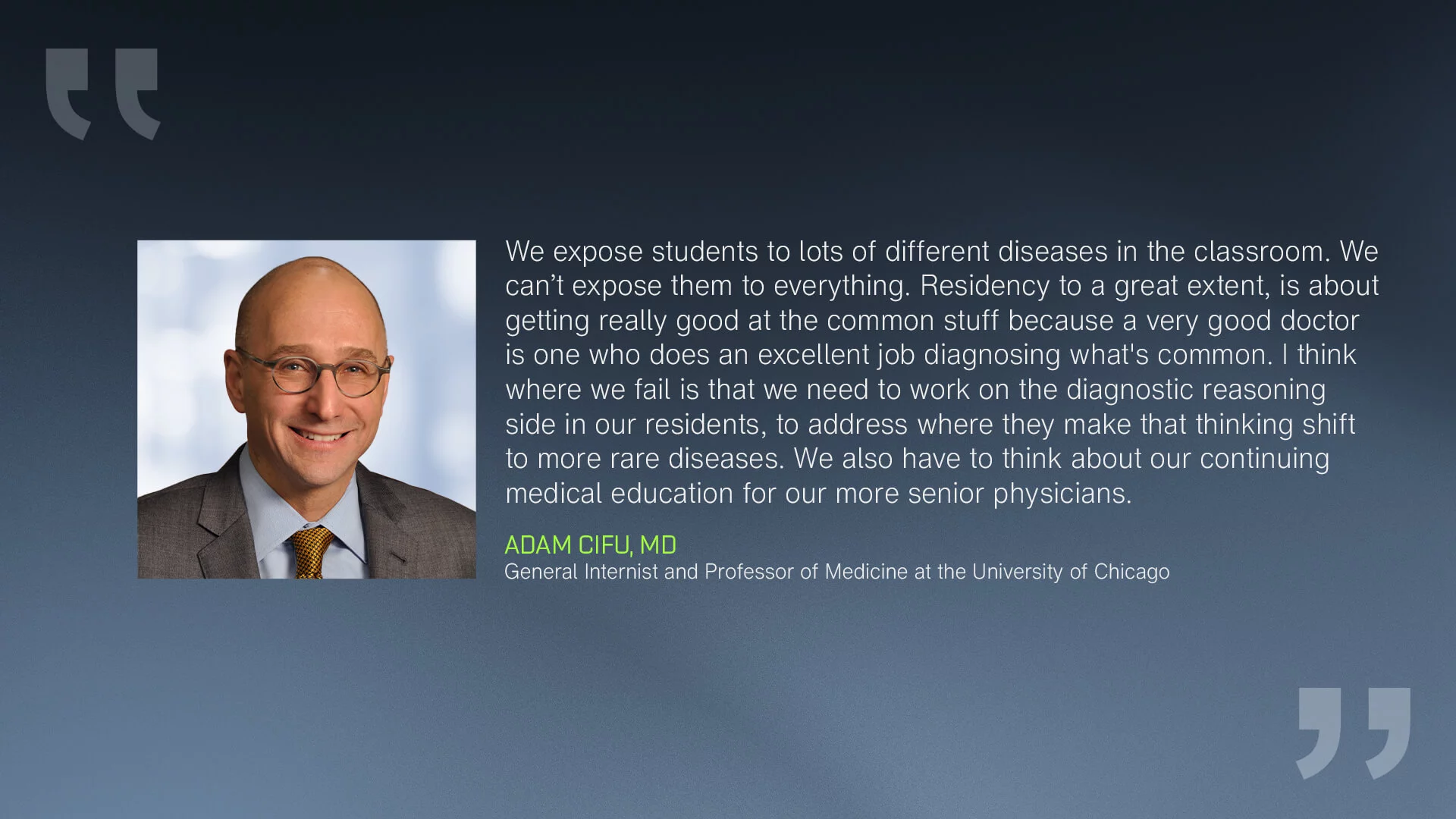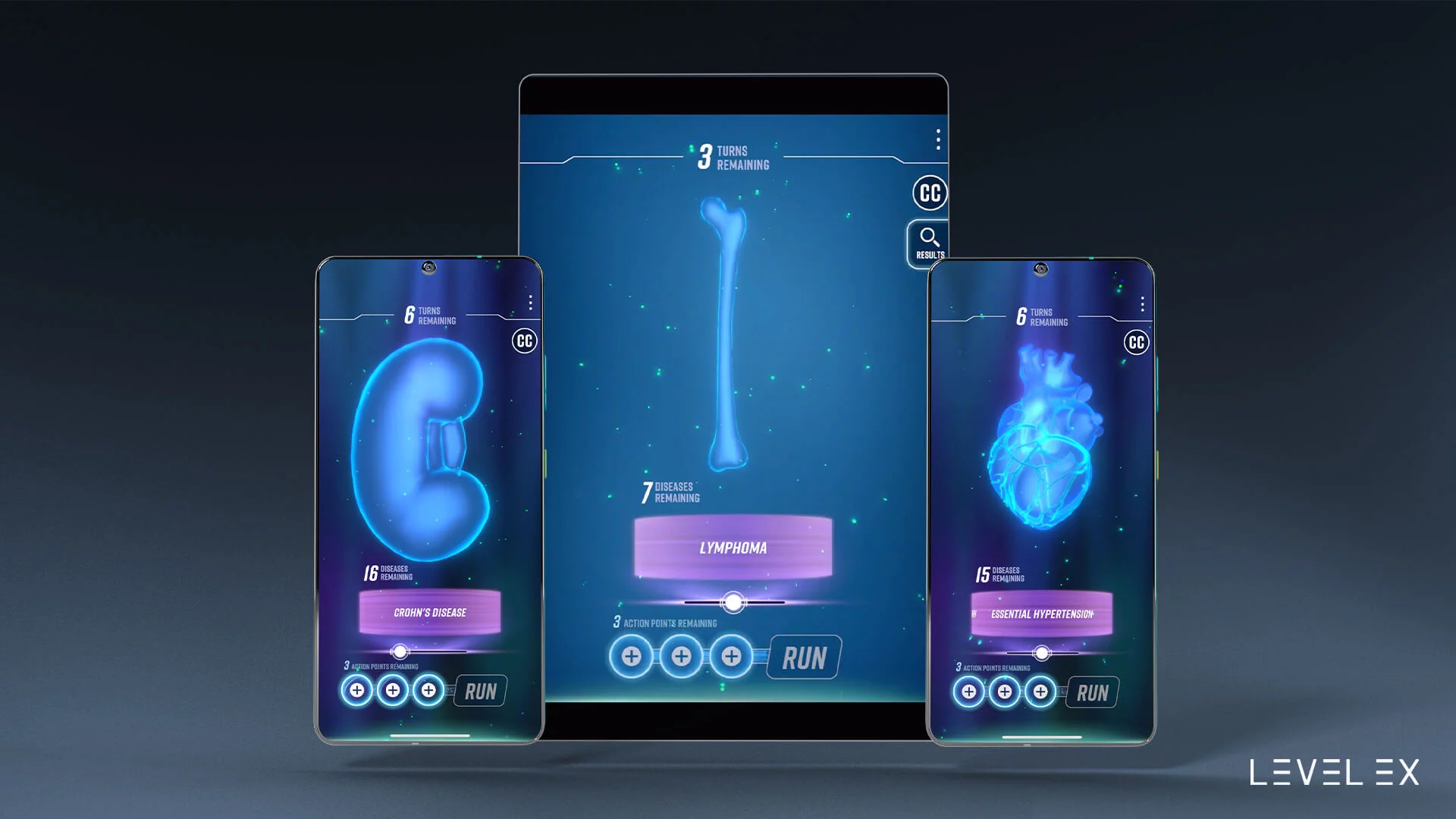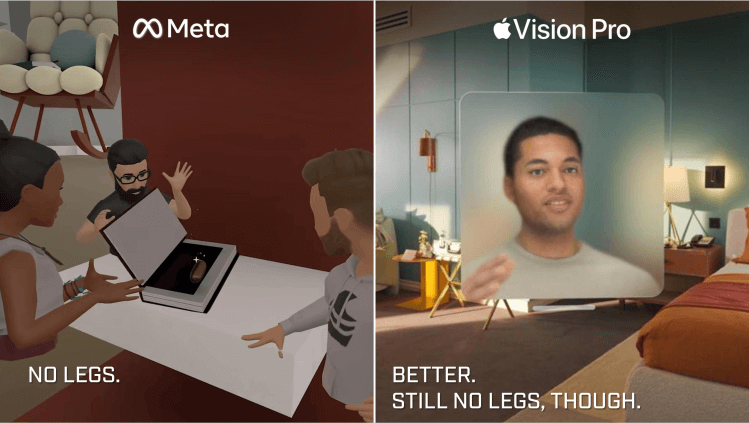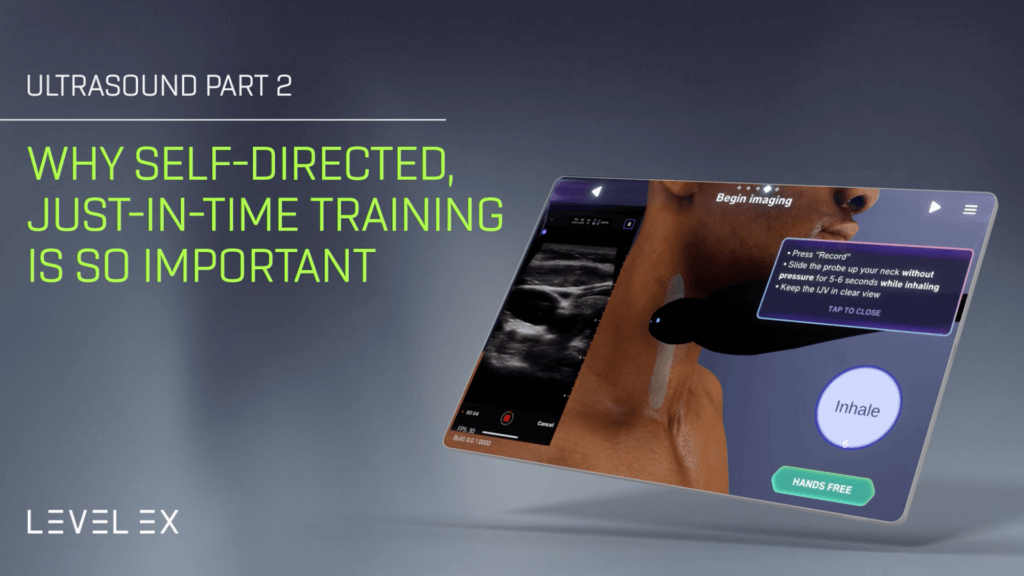
Rare Diseases Q&A: How to Better Spot Zebras in the Herd
Learn how clinicians can remove barriers and improve training to uncover uncommon diseases.
Rare diseases affect more than 25 million patients in the U.S., yet research shows it takes between one and five years before many patients receive an accurate diagnosis. We sat down with Adam Cifu, MD, a general internist and Professor of Medicine at the University of Chicago, to discuss why rare diseases often fall under the radar, what diagnostic challenges clinicians and patients face, and what changes could improve detection.
Q. What common challenges do clinicians encounter when it comes to rare diseases?
A. The first barrier is that we as physicians are taught in our diagnostics to think about epidemiology first. In your daily practice, you’re going to be seeing common things over and over again. Those are the things that come to mind. If you’re thinking about rare diseases everyday, you’re probably not practicing efficiently because you’re getting caught up in things you are so unlikely to find. And with rare diseases by definition, even if you’ve read about them in medical school or residency, because you’re seeing them so infrequently, you’re going to forget about them. They are not going to be easily accessible in your memory. Those challenges make it very difficult for a patient who is coming in with a rare disease, even if they are presenting with symptoms that are classic for a rare disease. The physician is going to take more time, need to think about who they need to call upon for help, and probably need to work a little harder to come to the correct diagnosis.

Q. While clinicians can’t go into every patient case thinking it’s a rare disease, how do we train doctors to consider rare disease more often? What should trigger that mindset?
A. Students in their first clinical year, what’s exciting about them is that they know an impressive array of diseases. But they haven’t ranked those diseases in their minds. We sort of teach them the hypothetico-deductive method thinking first, and the thinking, pattern recognition comes later, with experience. But once you’re more experienced, it’s unlikely you are going to make one of these difficult diagnoses of a rare disease the first time you meet a patient. More likely, the person is going to come in and their symptoms are going to fit something you see commonly, and you’re going to go after that first. Where we need to do a better job training physicians is when the patient returns and is not getting better. It should really be on visit two, that the doctor is not doubling down on the three diagnoses they thought the first time. That’s where I think we can do a lot better in thinking about and considering rare diseases.
Q. With all of the barriers and challenges, how long does it generally take a rare disease patient to get the correct diagnosis?
A. It depends on which disease, and it depends where the patient is seen the first time. Unfortunately, it also depends on who the patient is. We recognize there are a lot of disparities in healthcare and so people with the same diagnosis—women, minorities—tend to take longer for the correct diagnosis to be made. There are also practices that are set up for volume to get patients in and out quickly, such as clinics primarily taking care of healthier people. Patients with rare disease are better served with practices that have more expertise and more lenient scheduling that allow doctors and patients to dive more into symptoms.
Level Ex has a dedicated game mechanic for rare disease, honed and tested across multiple therapeutic areas. In Cardio Ex for example, players narrow down diseases through reductive reasoning. Our diagnosis game mechanic is deeply integrated into the game’s outer loops, in which a player’s success in playing diagnosis levels earns achievements, experience points, and in-game progress.
Q. Share some rare disease cases you have experienced during your career. How were the diagnoses made?
A. I’ll start with a patient who I saw fairly recently who came in with fatigue, a classic symptom of so many sick patients coming to the doctor. When I dove into his fatigue however, it wasn’t the kind of fatigue that most people complain of. This man was talking about intermittent, overwhelming fatigue during the day. My first thoughts were the usual things with fatigue: obstructive sleep apnea, poor sleep, hypothyroidism. None of those were the cause, so then I started thinking about less common disorders. I thought of possible narcolepsy. I started asking him about warning signs before the fatigue, and the only warning sign he could come up with was a foul smell he smelled. That triggered me to think about seizures and temporal epilepsy. Fortunately, we were able to make a correct diagnosis the next day, during a brain imaging. He had a CNS mass, a brain tumor.
Two intensive care cases also come to me that are super zebras. In one, we had a terribly sick man. The only really striking thing about him was horrible conjunctival erythema. His exposures were uninteresting, although he did work for public transit and did have a lot of contact with messy, not terribly clean tracks. It was a more senior nephrologist who was seeing him as a renal consult, who looked at the guy and said, “This is leptospirosis.” It remains the only time I’ve ever seen leptospirosis, a rare bacterial disease that can cause organ failure.
The second was a patient flown by helicopter from an outside hospital who had terrible pneumonia. We had taken the history and were treating him for all the usual suspects. A few days later, our infectious disease consult was talking to his wife and asked her if anything unusual had happened to him. The wife remembered that a week before, she had noticed a dead rabbit and asked her husband to “take care of it.” The man rode his lawn mower over the rabbit. It turned out he had tularemia, a disease especially prevalent in rabbits that can be passed to humans. He had tularemic pneumonia. We would have never known, but it was one person who didn’t even really have a diagnostic hypothesis, but who was diligent in figuring out all the possibilities to make the diagnosis.

Level Ex has developed various diagnostic experiences that help clinicians better identify rare diseases. In one rare disease experience, clinicians are led through the differential diagnosis of affected patients presenting with different sets of symptoms. The experience improves understanding of the disease and trains clinicians to include the disease in their early differential workflow.
Q. Is there enough training around rare diseases in early medical education? What about for older, experienced doctors as they go through their careers?
A. I think our medical schools do a good job in this area. We expose students to lots of different diseases in the classroom. We can’t expose them to everything. Residency to a great extent, is about getting really good at the common stuff because a very good doctor is one who does an excellent job diagnosing what’s common. I think maybe where we fail is that we need to work on the diagnostic reasoning side in our residents, to address where they make that thinking shift to more rare diseases.
We also have to think about our continuing medical education for our more senior physicians. I think we should say, “Ok, you’ve mastered 100 diagnoses that you see commonly in your practice, let’s start extending those little by little.” Wouldn’t it be neat if at specialty medical conferences, they had educational sessions on 5 things that you may never see, but if you do see them, you might be the person who saves a life. And even if you don’t make the diagnosis, you understand what difficult-to-diagnose diseases look like, how you should frame the differential, and maybe how you start the evaluation and get it to the person who is going to make the diagnosis.
Q. How do you think new technology and advancing analytics will impact the identification of rare diseases?
A. Clearly, artificial intelligence (AI) is going to be an enormous boon in parts of medicine—not as a replacement for doctors, but as incredible decision support. We’ve already made huge progress with the ability to read images, read pathology, and AI will make our radiologists and pathologists better, sort of like automated readings of EKGs have made our cardiologists better. A radiologist will be able to get through more chest X-rays and more mammograms with the aid of AI. It’ll key up some things that may have been missed
However, the problems with using an artificial intelligence model for first line diagnostics are that patient histories tend to be very non-specific and have to be read with an understanding of who this patient is, how they express themselves, how concerned they are—all those things which I can’t imagine this generation of computers being able to do. Not to mention, the lack of replicability from user to user. If two doctors examine the same person, we are unlikely to report the same thing or recognize things in the same way.
Where I think technology will really be able to help us is on those patients you’re seeing a second or a third time and you’re not making any progress. Being able to have a system where you can put symptoms, findings, epidemiology into the system, which will not give you a diagnosis, but will say, “here are three things you may not have thought about,” that’s going to be pulling up those rare diseases and potentially help lead you to the right diagnosis.
Level Ex recently honored their colleague Tom Huffman with a Game Jam that targeted Neuroendocrine Tumors (NETs), a rare disease initially misdiagnosed in 90% of NET patients. During Game Jams, Level Ex’ers design medical video games from scratch.
Q. What can clinicians improve on when it comes to rare diseases?
A. I think we can do a better job highlighting the patient’s role in their diagnosis. We’ve already talked about how it’s necessary to expand your thinking at that second or third visit if the patient is not improving. Part of that expansion could be listening more to the patient and taking note of what they are telling you that may be outside the norm. Hear about their symptom diary and address things that perhaps at the beginning, you did not feel were a productive area of the history. There may be something useful there if we listen more closely.
Thank you, Dr. Cifu. We’ve heard from an expert, now let’s hear from a patient. In the next part of our post, we speak with our own Mallory Pickard, Level Ex Strategy Director, about her personal journey with a rare disease and her road to the right diagnosis.
Q. Tell us about your illness and when your symptoms began?
A. Last April I was diagnosed with AOSD, which is adult onset Still’s disease, an autoinflammatory disorder. All my symptoms started in December, 2020. I never tested positive for Covid, but essentially every physician I talked to thought I had Covid. When I wasn’t getting better, they said, “We think you have long Covid, and that’s why you have so much fatigue and these fevers.” Weeks turned into a few months. I was seeing a neurologist and a cardiologist and a rheumatologist and all these folks to rule out all these different things. But it kind of got to the point when we had marked off the list all of these bigger conditions and the doctors still didn’t know what it was.
Q. What was the disease journey like for you, and how did the ongoing uncertainty impact you?
A. It was a whole rainbow of emotions. You get to a point where you’ve gone through so many tests and have invested quite frankly, from the patient perspective, a good amount of money trying to figure out what’s wrong with you, and the doctors keep saying, “Well, it’s not this and it’s not that.” When you hear that enough times, you wonder if this is psychological, if this is just me. And I literally would have to go look at pictures of the thermometer and other physical symptoms on my phone or MyChart, to remind myself that no, here’s the physical stuff that’s showing up, it’s real. So there’s that whole sort of psychological struggle with the unknown.You can hit low points and think, “I’m not even gonna bother anymore. Like I don’t want to hear one more person say, “Maybe you need to get more sleep.” Looking back, I was learning as I went that nothing is black and white in healthcare, and that being diagnosed with a rare disease is often a very long process of elimination.
Q. How was the diagnosis finally made?
A. A year and a half after my symptoms started, I was talking with a new rheumatologist about the journey I had been on. He said he’d just had a conversation with a physician colleague of his who is treating somebody with Still’s disease, and he said, “That’s what it sounds like to me.” So the only reason we started down this path and learned the diagnosis was because of his recent conversation with a colleague. The rheumatologist admitted that the only time he’d ever heard of AOSD was once in medical school. Until that day, I had never even heard of it, but it all made perfect sense.
Q. How are you today and what is your prognosis?
A. Well, some folks have symptoms of Stills all the time, and they need long-term medications or biologics to manage, I don’t have that. I do have regular fevers, but everything else is based on flare-ups, so I go through cycles that I’m learning to accept. Knowing I have AOSD gives me a framework for decision-making. There are the classic decisions like eating healthier and exercising enough, but I also know now to take rest more seriously, for example. It’s much easier to manage when you know what you’re dealing with and can start to understand your limitations.
Q. Considering your disease journey, how does it feel working for a medical game studio, and how do you think our work can help patients such as yourself?
A. The first thing that comes to mind is just that unique opportunity we have to leverage game mechanics that create memorability and recall for good. We know that rare diseases are sort of learned about and forgotten after medical school, like in the case of my AOSD and the rheumatologist who just happened to hear about it from a colleague. The fact that we can take a collection of rare diseases or just one rare disease type and build a game experience to help doctors with recall across the board to potentially shorten the time to diagnosis, that’s so compelling. Being able to step in and create awareness where we need to, make it easier for physicians to identify and recall lesser known diseases and insights is life-changing for so many patients.
Level Ex has developed various games and experiences that help medical professionals recognize and more quickly identify uncommon conditions. To learn more about how we target rare diseases or to view our rare disease case study, contact us.


